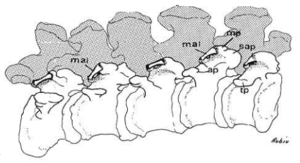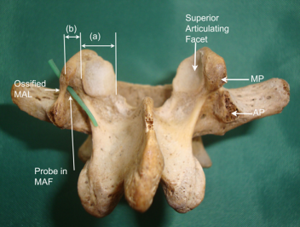Ligaments of the Lumbar Spine: Difference between revisions
No edit summary |
No edit summary |
||
| Line 14: | Line 14: | ||
==Further Reading== | ==Further Reading== | ||
[[Media:bogduk1981 MAL.pdf]] | [[Media:bogduk1981 MAL.pdf]] | ||
==References== | |||
[[Category:Partially complete articles]] | [[Category:Partially complete articles]] | ||
[[Category:Spine Anatomy]] | [[Category:Spine Anatomy]] | ||
Revision as of 07:44, 1 March 2021


There is a notch between the mamillary process and accessory process on each side of every lumbar vertebra. This notch is converted into a foramen by the mamillo-accessory ligament, through which the medial branch of the dorsal ramus passes through to supply the facet joint and multifidus. The ligament at any segment is related to the nerve of the next caudal segment (e.g. the L5 ligament is related to the L4 medial branch).
It is not a true ligament because it connects two points on the same bone. Its structure resembles a tendon more than a ligament and it has been interpreted as being a tendon of the semispinalis musculature in the lumbar spine. It is about 1-2mm thick.
The ligament can be ossified which converts the notch into a bony foramen, which is a normal phenomenon in a minority of people.
The structure has no biomechanical significance.
Further Reading
References
- ↑ Bogduk. The lumbar mamillo--accessory ligament. Its anatomical and neurosurgical significance. Spine 1981. 6:162-7. PMID: 6456553. DOI.
- ↑ Mahato. Mamillo-accessory notch and foramen: distribution patterns and correlation with superior lumbar facet structure. Morphologie : bulletin de l'Association des anatomistes 2014. 98:176-81. PMID: 24889272. DOI.

